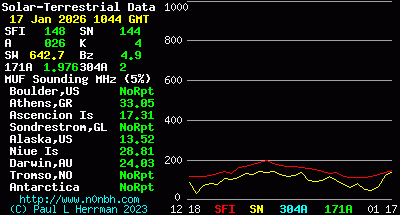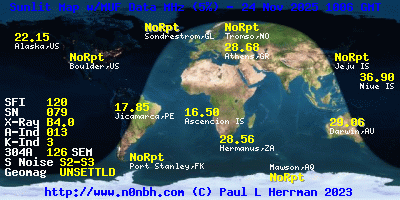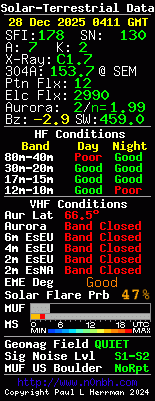Propagation
data
Charts by kind permission of
Paul L Herrman. Visit http://www.hamqsl.com/solar.html
  |

|
SFI [High is good for
20mtrs and up]
(Radio
noise at 2800Mhz/10.7cm)
70 or less - Poor
80-90 Low
90-100 Average
100- 150 Good
>150 Ideal
SN [High is good for
20mtrs and up]
(Sunspots)
50
or less - Poor
50-75 conditions attenuated
75-100 Good
100 - 150 ideal
>150 exceptional
The A Index [Low is good for 20mtrs and up]
1 - 6 is Best
7 - 9 is OK
11+ is BAD
The K Index [Low is good for 20mtrs and up]
0 or 1 is BEST
2 is OK
3 or more is BAD
5+ don't bother turning the rig on!
XRay [Low is good for
20 mtrs and up]
B:
Very Low
C: Moderate
M: Moderate to high
X: High to extreme
|
| |
The
Solar Cycle
Solar
Cycle 25 began in December 2019 and is expected to peak in 2025,
according to the Solar Cycle 25 Prediction Panel, an International
group of experts co-sponsored by NOAA and NASA.
December 2019 was the "Solar Minimum" or period of the least solar
activity in the eleven yeat solar cycle.
|
|
A-
and K-index:
Geomagnetic activity indices, high indices (K:>5 or
A:>20) means stormy conditions with an active geomagnetic field.
The more active, the more unstable propagation with possible periods of
total propagation fade-out. Especially around the higher latitudes and
especially at the polar regions, where the geomagnetic field is weak,
propagation may disappear completely. Extreme high indices may result
in aurora propagation, with strongly degraded long distance propagation
at all latitudes. Sporadic-E is strongest during low indices. Low
indices result in relative good propagation, especially noticeable
around the higher latitudes, when transpolar paths may open up. Maximum
K-index is 9, and the A-index can exceed well over 100 during very
severe storm conditions, with no maximum. The ARRL often reports the
K-index from the Alaskian station where this index is known as the
College K-index. Other stations reporting K-indices include Planetary
and Boulder. In contrast, the A-indices are usually reported for the
Planetary station only.
The higher the K-index, the more unstable
propagation becomes, the effect is stronger at high latitudes, but
weaker near low latitudes.
When storm level is reached, propagation strongly degrades, possibly
fade out at high latitudes.
Classification of K-indices are as follows:
K0=Inactive
K1=Very quiet
K2=Quiet
K3=Unsettled
K4=Active
K5=Minor storm
K6=Major storm
K7=Severe storm
K8=Very severe storm
K9=Extremely severe storm
As with the K-index, the higher the A-index, the
more unstable propagation becomes.
Classification of A-indices are as follows:
A0 - A7 = quiet
A8 - A15 = unsettled
A16 - A29 = active
A30 - A49 = minor storm
A50 - A99 = major storm
A100 - A400 = severe storm
Background
X-ray level: This may vary from B (very
low), C (low to moderate), M (moderate to high) to X (high to extremely
high), the higher the number after the letter, the stronger the X-ray
radiation. So an X0.1 is stronger than an M9.9. High amounts of X-ray
radiation causes intense ionization of the D-layer, resulting in strong
absorption of HF-signals. Solar flares are commonly measured in the
amount of X-ray radiation.
Solar
Flux: This
flux number is measured from the amount of radiation on the 10.7cm band
(2800MHz). It is closely related to the amount of ultraviolet
radiation, which is needed to create an ionosphere. The lowest possible
number for this solar flux is 63.75. Single hop propagation already
starts at 70 in lower latitude areas. Worldwide long distance
propagation (DX) may turn up already with a solar flux at 120. From
experience, an average solar flux of 170 seems to be ideal for 10m-20m
bands QRP DX with good possibilities during these conditions to reach
every possible part of the globe with a simple dipole running as low as
5 Watts!
304A: Relative
strength of total solar radiation at a wavelength of 304 Angstroms
(30.4nm).
Loosly correlates to the Solar Flux Index.
PTN
Flux: Proton
Flux measurement. The amount of proton activity in the solar wind.
Primarily affects propagation in the E Layer.
ELC
Flux: Electron
Flux measurement. The amount of electron activity in the solar
wind. Primarily affects propagation in the E Layer.
Aurora:
N number
reflects probabilty of aurora activity. Scale of 0 - 5 with 0 being
high probability and 0 low.
The reference above is reproduced by kind
permission of Edwin C. Jones, MD, PhD (AE4TM)
Department of Physics and Astronomy,
University of Tennessee, Knoxville, TN 37996-1200
VE3EN's Website www.solarham.com
is an excellent resource for upto date solar and propagation data.
The definitions page (www.solarham.com/help.htm) is
particularly useful for interpreting results.
|



